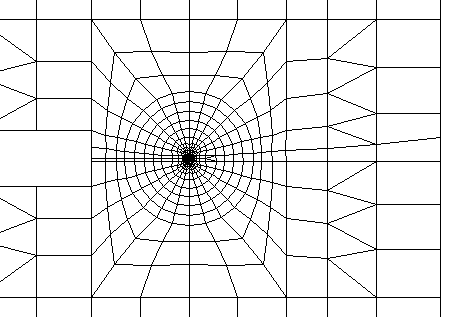3. Modeling A#
3.1. Characteristics of modeling#
The entire test piece is meshed into quadrangular elements with 4 knots or triangular elements with 3 knots.
It has 799 nodes, 624 quadrangles, 185 triangles, and 261 segments.
3.2. Characteristics of the mesh#
Very small elements (\(\mathrm{0,02}\mathrm{mm}\)) at the tip of the crack.
The first ring is located in a single material, the 4 other rings cross the interface between the two materials.

3.3. Tested sizes and results#
The energy return rate \(G\) is calculated by the \(\mathrm{THETA}\) method for the following 5 crowns:
Crown 0: \({R}_{\mathrm{inf}}=\mathrm{0,02}\mathrm{mm}\) \({R}_{\text{sup }}=\mathrm{0,18}\mathrm{mm}\)
Crown 1: \({R}_{\mathrm{inf}}=\mathrm{0,2}\mathrm{mm}\) \({R}_{\text{sup}}=1\mathrm{mm}\)
Crown 2: \({R}_{\mathrm{inf}}=1\mathrm{mm}\) \({R}_{\text{sup}}=2\mathrm{mm}\)
Crown 3: \({R}_{\mathrm{inf}}=2\mathrm{mm}\) \({R}_{\text{sup}}=3\mathrm{mm}\)
Crown 4: \({R}_{\mathrm{inf}}=3\mathrm{mm}\) \({R}_{\text{sup}}=5\mathrm{mm}\)
Tested values
Identification |
Reference J ASTM |
Aster |
\(\text{\%}\) difference |
|
G (N/mm) Crown No. 0 UY=0.2 mm |
5.8 |
6.0 |
3.1 |
|
G (N/mm) Crown No. 0 UY=0.4 mm |
22.6 |
23.2 |
2.8 |
|
G (N/mm) Crown No. 0 UY=0.6 mm |
47.2 |
48.2 |
2.0 |
|
G (N/mm) Crown No. 0 UY=0.8 mm |
74.7 |
75.0 |
0.5 |
|
G (N/mm) Crown No. 0 UY=1.0 mm |
103.7 |
102.8 |
-0.8 |
|
G (N/mm) Crown #1 UY=0.2 mm |
5.8 |
6.10 |
4.6 |
|
G (N/mm) Crown #1 UY=0.4 mm |
22.6 |
23.2 |
2.8 |
|
G (N/mm) Crown #1 UY=0.6 mm |
47.2 |
47.3 |
0.1 |
|
G (N/mm) Crown #1 UY=0.8mm |
74.7 |
73.1 |
2.2 |
|
G (N/mm) Crown #1 UY=1.0mm |
103.7 |
99.8 |
3.8 |
|
G (N/mm) Crown #2 UY=0.2 mm |
5.8 |
6.1 |
4.3 |
|
G (N/mm) Crown #2 UY=0.4 mm |
22.6 |
23.3 |
3.2 |
|
G (N/mm) Crown #2 UY=0.6 mm |
47.2 |
48.0 |
1.6 |
|
G (N/mm) Crown #2 UY=0.8mm |
74.7 |
74.9 |
0.3 |
|
G (N/mm) Crown #2 UY=1.0 mm |
103.7 |
103.7 |
103.1 |
0.3 |
Identification |
Reference J ASTM |
Aster |
\(\text{\%}\) difference |
G (N/mm) Crown #3 UY=0.2 mm |
5.8 |
6.1 |
4.4 |
G (N/mm) Crown #3 UY=0.4 mm |
22.6 |
23.3 |
3.3 |
G (N/mm) Crown #3 UY=0.6 mm |
47.2 |
48.2 |
1.9 |
G (N/mm) Crown #3 UY=0.8mm |
74.7 |
75.5 |
1.0 |
G (N/mm) Crown #3 UY=1.0 mm |
103.7 |
104.2 |
0.4 |
G (N/mm) Crown No. 4 UY=0.2 mm |
5.8 |
6.1 |
4.5 |
G (N/mm) Crown No. 4 UY=0.4 mm |
22.6 |
23.4 |
3.4 |
G (N/mm) Crown No. 4 UY=0.6 mm |
47.2 |
48.2 |
2.1 |
G (N/mm) Crown #4 UY=0.8mm |
74.7 |
75.5 |
1.1 |
G (N/mm) Crown #4 UY=1.0 mm |
103.7 |
104.4 |
0.7 |
Stability of \(G\) with the choice of crowns
Identification |
Crown 2 |
Crown 3 |
Crown 4 |
\(\text{\%}\) Maximum variance |
|
G (N/mm) UY=0.2mm |
6.1 |
6.1 |
6.1 |
6.1 |
0.2 |
G (N/mm) UY=0.4mm |
23.3 |
23.3 |
23.4 |
0.1 |
|
G (N/mm) UY=0.6mm |
48.0 |
48.2 |
48.2 |
0.4 |
|
G (N/mm) UY=0.8mm |
74.9 |
75.5 |
75.5 |
0.5 |
|
G (N/mm) UY=1.0mm |
103.1 |
103.1 |
104.2 |
104.4 |
0.4 |
3.4. notes#
In all cases, the absolute value of the difference in the calculation of \(G\) is less than \(\text{5\%}\). For rings 3 to 5, the difference decreases as a function of the displacement to reach an almost zero value.
The stability on rings 2, 3 and 4 is very good, the gap between rings is always less than \(\text{0,5 \%}\).